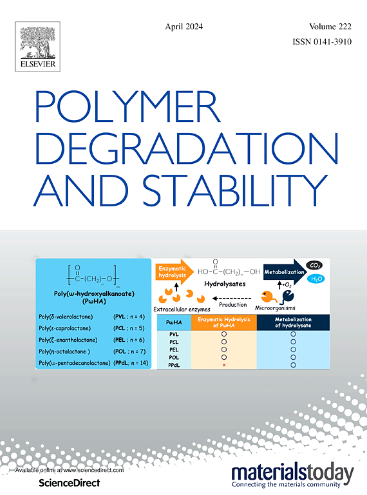在不同海拔高度的工业碳纤维生产线上比较氧分压对 PAN 纤维微观结构演变的影响
IF 6.3
2区 化学
Q1 POLYMER SCIENCE
引用次数: 0
摘要
了解和调节聚丙烯腈(PAN)原纤维的氧化稳定行为是高性能碳纤维生产技术的关键课题。在此,我们在不同地区(不同氧分压环境)的工业碳纤维生产线上对 PAN 纤维进行了连续稳定和碳化,并在不同阶段对纤维的微观结构演变进行了系统分析。氧化稳定气氛中的氧分压对碳纤维拉伸模量的影响非常明显。在氧化稳定过程中,氧气扩散到 PAN 纤维中,在氧分压较高的气氛中产生了更均匀的交联结构,并使稳定后的纤维具有较低的皮芯比。广角 X 射线衍射(WAXD)表明,较高的氧分压条件有助于产生更高的晶粒优选取向和更大的晶粒尺寸,拉曼光谱也证实了在较高氧分压条件下获得的碳纤维具有更有序的石墨结构。因此,空气中相对较高的氧分压使稳定纤维具有更多的交联结构,有助于形成高性能碳纤维。本文章由计算机程序翻译,如有差异,请以英文原文为准。
A comparison of the effect of oxygen partial pressure on microstructural evolution of PAN fibers during industrial carbon fiber production line at different altitudes
Understanding and regulating the oxidative stabilization behavior of polyacrylonitrile (PAN) precursor fibers are critical subjects of high-performance carbon fiber production technologies. Here, we performed continuous stabilization and carbonization of PAN fibers at industrial carbon fiber production lines in different locales (different oxygen partial pressure in atmosphere), and investigated the microstructural evolution of the fibers with a systematically analysis at different stages. Influence of oxygen partial pressure in oxidative stabilization atmosphere on tensile modulus of the obtained carbon fibers was obvious. Oxygen diffused into PAN fibers during oxidative stabilization, more homogeneous and crosslinked structures generated under higher oxygen partial pressure atmosphere, and gave the stabilized fibers lower skin-core ratio. The graphite layers gradually generated in the subsequent carbonization stages, and the gathered graphite layers transformed into graphite microcrystalline, the wide-angle x-ray diffraction (WAXD) demonstrated that higher oxygen partial pressure conditions contributed to the generation of higher crystallite preferred orientation and bigger crystallite size, Raman spectroscopy also confirmed the obtained carbon fibers with higher oxygen partial pressure conditions possessed more ordered graphite structures. Thus, relatively higher oxygen partial pressure in air gave the stabilized fibers more crosslinked structures, and contributed to the formation of high-performance carbon fibers.
求助全文
通过发布文献求助,成功后即可免费获取论文全文。
去求助
来源期刊

Polymer Degradation and Stability
化学-高分子科学
CiteScore
10.10
自引率
10.20%
发文量
325
审稿时长
23 days
期刊介绍:
Polymer Degradation and Stability deals with the degradation reactions and their control which are a major preoccupation of practitioners of the many and diverse aspects of modern polymer technology.
Deteriorative reactions occur during processing, when polymers are subjected to heat, oxygen and mechanical stress, and during the useful life of the materials when oxygen and sunlight are the most important degradative agencies. In more specialised applications, degradation may be induced by high energy radiation, ozone, atmospheric pollutants, mechanical stress, biological action, hydrolysis and many other influences. The mechanisms of these reactions and stabilisation processes must be understood if the technology and application of polymers are to continue to advance. The reporting of investigations of this kind is therefore a major function of this journal.
However there are also new developments in polymer technology in which degradation processes find positive applications. For example, photodegradable plastics are now available, the recycling of polymeric products will become increasingly important, degradation and combustion studies are involved in the definition of the fire hazards which are associated with polymeric materials and the microelectronics industry is vitally dependent upon polymer degradation in the manufacture of its circuitry. Polymer properties may also be improved by processes like curing and grafting, the chemistry of which can be closely related to that which causes physical deterioration in other circumstances.
 求助内容:
求助内容: 应助结果提醒方式:
应助结果提醒方式:


